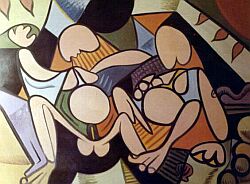 Harry
Daniel Michael was born of American parents on December 14th,
1953 on the tiny Dutch island of Aruba. Located just fifteen
miles off the coast of Venezuela, Aruba is what dreams are made of.
From its rocky windswept cliffs to turquoise waters, to bleach white sand
beaches, this tiny gem of the Caribbean was destined to produce an
artist as unique as itself. Harry
Daniel Michael was born of American parents on December 14th,
1953 on the tiny Dutch island of Aruba. Located just fifteen
miles off the coast of Venezuela, Aruba is what dreams are made of.
From its rocky windswept cliffs to turquoise waters, to bleach white sand
beaches, this tiny gem of the Caribbean was destined to produce an
artist as unique as itself.  However,
there are no tales of this baby being born with brush in hand.
He was too busy in the warm sun exploring the many wonders the island held
in store. At a mere 20x5 miles, Aruba was home to what was
once the world's largest oil refinery, the Lago Oil and Transport
Company. Harry's father worked there 17 years as an Assistant
Supervising Engineer. His mother stayed active raising Harry, his
sister and four brothers. This blend of influences created
an atmosphere which inspired Harry to begin drawing, but it wasn't
until age seven that Harry's parents began to take notice of their son's
artistic ability. Harry's teachers were constantly sending
him home for etching on desktops. As his notebooks turned into sketchbooks,
his parents brought him to the attention of Pablo Pandellis, a local
painter, who began to instruct the youngster in the art of drawing.
These lessons consisted of lazy afternoons spent etching in charcoal and
pencil. Pandellis would occasionally peek over Harry's shoulder and
offer expert advice. Sadly, these lessons came to an abrupt
end when Pandellis died of a heart attack during Harry's sixth lesson. However,
there are no tales of this baby being born with brush in hand.
He was too busy in the warm sun exploring the many wonders the island held
in store. At a mere 20x5 miles, Aruba was home to what was
once the world's largest oil refinery, the Lago Oil and Transport
Company. Harry's father worked there 17 years as an Assistant
Supervising Engineer. His mother stayed active raising Harry, his
sister and four brothers. This blend of influences created
an atmosphere which inspired Harry to begin drawing, but it wasn't
until age seven that Harry's parents began to take notice of their son's
artistic ability. Harry's teachers were constantly sending
him home for etching on desktops. As his notebooks turned into sketchbooks,
his parents brought him to the attention of Pablo Pandellis, a local
painter, who began to instruct the youngster in the art of drawing.
These lessons consisted of lazy afternoons spent etching in charcoal and
pencil. Pandellis would occasionally peek over Harry's shoulder and
offer expert advice. Sadly, these lessons came to an abrupt
end when Pandellis died of a heart attack during Harry's sixth lesson.
Harry gravitated to experimenting in oils,
with the sweet smells of turpentine and linseed oil acting as a painter's
aphrodisiac. The first paintings at age ten reflect the natural
settings of Aruba and the rugged native fishermen, banana boats in
the harbor, and the knarled look of a divi-divi tree silhouetted
against a rocky landscape.
"Aruban Divi-Divi"
painted in oils at age 10>
|
 |

At age 12 he sold his first painting, depicting the fishing
boats in harbor with the day's catch still in the nets. |

|
 "Church at Sitges"
"Church at Sitges"
Oil on Canvas, 1971
|
In 1966, Harry and his family moved to north central Florida
and settled in Gainesville, a small college town. By age 14 he had
sold several more paintings and found himself with an eager group of patrons.
At age 16, following a prodigious output, Harry was able to
finance his own trip to Europe and spent nearly one year traveling through
Germany, France, Switzerland, Holland and Monaco. He lived
for a time in Sitges, Spain, on the mediterranean coast, where he
painted continuously until the local police forced him to leave.
It seems a local ordinance prohibited painting on the beach,
a favored spot for the young artist. Eventually,
Harry returned to the United States as a young man brimming with tales
of adventure and excitement. |
|
|
Now back in Florida, Harry participated in outdoor art shows around
the state and at age 19 joined a traveling artists caravan called the California
Professional Artists Society. This unique group of 45 artists
and their families traveled eleven months out of the year to 38 major cities
to exhibit daily inside large shopping malls. Harry's ability to
paint serious detailed compositions in front of milling crowds gained incredible
exposure from the over one million people who visited the shows during
the two years he was a member.

 During
his early twenties, he plunged into surrealism, apparently
under the influence of Salvador Dali. While Harry's style and technique
showed a remarkable resemblance, this genre was not enough
to satisfy the young artist's thirst for his own style. During this
time, he was commissioned to produce posters for the Great Southern Music
Hall, a Gainesville concert venue. He conceived the promotional
artwork for performers such as B.B. King, Labelle, Melissa
Manchester, Cheech & Chong and Steve Martin. During
his early twenties, he plunged into surrealism, apparently
under the influence of Salvador Dali. While Harry's style and technique
showed a remarkable resemblance, this genre was not enough
to satisfy the young artist's thirst for his own style. During this
time, he was commissioned to produce posters for the Great Southern Music
Hall, a Gainesville concert venue. He conceived the promotional
artwork for performers such as B.B. King, Labelle, Melissa
Manchester, Cheech & Chong and Steve Martin.
|